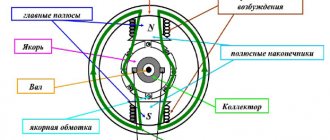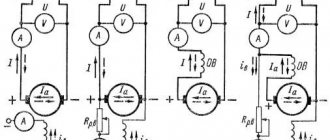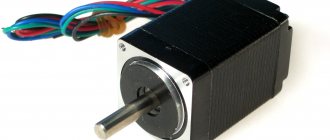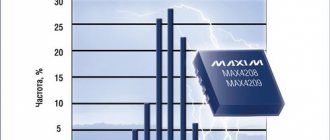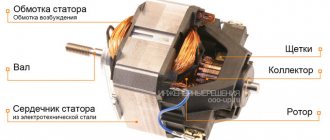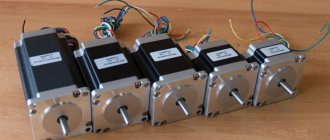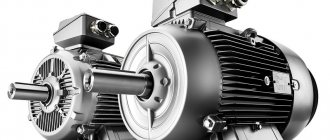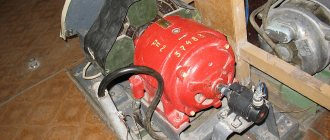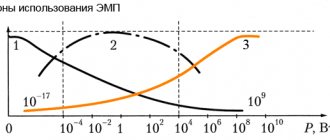Placing a permanent magnet in the rotor (internal configuration) and controlling the surrounding coils through transistors eliminated the most important disadvantage of brushed (commutated) DC motors, which are the brushes themselves.
In an alternative configuration (outward stroke), the armature coils may form a solid core around which a permanent magnet rotor rotates, driving the motor shaft. In both cases the coils are stationary.
BLDC motors are considered electronically commutated motors (ECM), as opposed to brushed mechanically commutated motors.
General principle of BLDC motor control
BLDC motors require advanced electronic controllers that can sense the rotor position. For this purpose, you can use a Hall sensor that responds to the position of each armature coil when the engine is running. The speed of a BLDC motor can no longer be controlled by voltage, as in brushed motors, but only by changing the switching frequency. These motors are powered by a PWM signal as shown in the figure.
BLDC motors are divided into 1-phase, 2-phase and 3-phase, but the operating principle is common to all types. Instead of a mechanical commutator that changes the direction of the magnetic field of the rotor coils, transistors are used that continuously change the phase of the voltage supplied to the stator coil, which causes the rotor to rotate continuously.
Single-phase brushless motors are used in low-power applications, while two-phase motors are more common in medium-power applications. Typical applications for 3-phase motors are CD-ROM readers.
General information, device, scope of application
One of the reasons for the interest in BD is the increased need for high-speed micromotors with precise positioning. The internal structure of such drives is shown in Figure 2.
Rice. 2. Brushless motor design
As you can see, the design consists of a rotor (armature) and a stator, the first has a permanent magnet (or several magnets arranged in a certain order), and the second is equipped with coils (B) to create a magnetic field.
It is noteworthy that these electromagnetic mechanisms can be either with an internal armature (this type of design can be seen in Figure 2) or external (see Figure 3).
Rice. 3. Outrunner design
Accordingly, each of the designs has a specific scope of application. Devices with an internal armature have a high rotation speed, so they are used in cooling systems, as power plants for drones, etc. External rotor actuators are used where precise positioning and torque resistance are required (robotics, medical equipment, CNC machines, etc.).
Brushless motor in a computer disk drive
Empire - Online video search service
Tired of missing premieres at the cinema because of the frenzied rhythm of life? Tired of the fact that on television, the films are being broadcast at an inconvenient time for you? In your family, often your relatives divide the remote from the TV? The child asks to see cartoons for children, when you are busy, and on the channels there are no good cartoons? And, in the end, Do you just want to relax after a hard day on the sofa in your home clothes for watching an interesting movie or series?
To do this, it is best to always have a favorite site in your bookmarks, which will become your best friend and helper. And how to choose such a site, when there are so many? - you ask. The best choice for you will be imperiya.by
Why our resource? Because it combines many positive features that make it universal, convenient and simple. Here is a list of the main advantages of the resource.
- Free access. Many sites ask customers to buy a subscription, than our portal does not deal with, because it believes that people should have free access to the Internet in everything. We do not charge viewers for our viewers!
- You do not need any registration and SMS for questionable phone numbers. We do not collect confidential information about our users. Everyone has the right to anonymity on the Internet, which we support.
- Excellent video quality. We upload content exclusively in HD format, which certainly can please your favorite users. It is much more pleasant to watch a good movie with a quality picture than with a picture of poor quality.
- A huge choice. Here you will find a video for every taste. Even the most inveterate moviegoer will always find what to see from us. For children there are cartoons in good quality, cognitive programs about animals and nature. Men will find interesting channels for themselves about news, sports, cars, as well as about science and technology. And for our beloved women, we picked up a channel about fashion and style, about celebrities, and of course music videos. Having arranged an evening with your family, or with friends, you can pick up a merry family comedy. A loving couple to luxuriate in watching a love melodrama. After a day of work, a thrilling series or a detective helps to relax. Movies in HD format of the new time and past years are presented to absolutely any taste and can satisfy the needs of any viewer.
- Ability to download video. Absolutely any material on the site can be downloaded to your computer or USB flash drive. If suddenly you are going to a dacha with a laptop where there is no internet, or you want to watch a movie on a big screen of the TV, you can always download in advance, and then look at the right time. In this case, you do not have to wait for your turn to download the video, as it happens on torrents or other similar sites.
- Security. We monitor the cleanliness of the content, every file is checked before uploading. Therefore, there are no viruses and spyware on our site, and we carefully monitor this.
- New. We regularly update and add new animations, serials, TV shows, music videos, news, reviews, animated series, etc. to the portal. and all this you can see for free, without registration and SMS. We are trying for you, for our favorite visitors.
- Online browsing On our site, it is not necessary to first download a movie to view it, simply turn it on and enjoy it. Thanks to the professional setup, there will be no braking, and nothing can stop you from watching an interesting movie.
- Bookmark. On the site you can click a button with an asterisk to poison the video in the bookmarks and return to it later. Everyone, for certain, happened that he saw on the site an interesting video that you want to see, but right now there is no possibility. This button will help you with this and, having freed yourself, you can easily see what you like.
- User-friendly interface. Finding the right video will not take you long, as the site is best adapted to users, and everything is intuitively understandable. Even a child will be able to understand and include for himself a cartoon or some program about animals, nature.
Cinema as art appeared relatively recently, but already managed to closely intertwine with our lives. A lot of people because of the haste of our time for years did not go to the theater, to the gallery or museums. However, it is difficult to imagine a person who did not watch the series or the film for at least a month. Cinema is a synthesis of theater, music, fine arts and literature. It gives even the busiest person, who does not have time to go to theaters and galleries, to be Thus closer to art and to improve spiritually.
The cinema also occupied the sphere of public entertainment. Watch comedies, fighters, westerns, etc. fits perfectly into any some evening with my family. Horrors perfectly tickle the nerves of even the most fearless person. Cartoons adore children, and some can be viewed by the whole family. Cognitive videos help to expand knowledge, look at the world wider and satisfy your own natural curiosity.
A man in the twenty-first century can no longer imagine his life without the technology of the future, it seems that in the future, machines, robots and technics can replace a person, or rather perform many automatic works, so everyone wants to see what technologies will be in the future. On imperiya.by you do not need to postpone the scan, just add the video to the bookmarks and at any time you can return to it and have a great time watching the quality video.
Do not deny yourself the pleasure, start watching right now! Meet the updates, with new items, choose what you would like to see later. Pleasure yourself and your family with interesting films in good quality!
imperiya.by
Brushless Motor Control
Electric motor - https://goo.gl/9CBLtX OR - https://goo.gl/SX5NrN Kit - https://goo.gl/P9WYhK Battery - https://goo.gl/oBNZW3 Regulator...
Speed Controller for Brushless Motor
Speed controller for small sensorless brushless motors (Sensorless BLDC). The ideal drive for…
Starting a brushless motor without a speed controller
Starting a brushless motor without a speed controller.
Controlling a brushless motor from a PC via Arduino Nano
❓How to start a motor from a hard drive
Today I will show you 5 ways to start a hard drive motor and control its rotation speed!…
Arduino Lessons - Brushless Motor Control
In this issue we will learn how to control brushless motors using Arduino,…
Brushless DC (BLDC) motor and Arduino
A simple and not entirely correct connection of the BLDC motor to the arduino, using the L298N half-bridge driver liter...
Brushless motors from computer and arduino
or we connect the motor from the flop and HDD to the arduino using the L298N bridge driver https://arrduinolab.blogspot.com/2014/09/blog-pos…
food-health-vika.com
Principle of operation
Unlike other drives, for example, an AC asynchronous machine, the BD requires a special controller to operate, which turns on the windings in such a way that the vectors of the magnetic fields of the armature and stator are orthogonal to each other. That is, in essence, the driver device regulates the torque acting on the DB armature. This process is clearly demonstrated in Figure 4.
Phases of operation of a brushless drive
As you can see, for each movement of the armature it is necessary to perform a certain commutation in the stator winding of a brushless type motor. This principle of operation does not allow smooth control of rotation, but makes it possible to quickly gain momentum.
Differences between brushed and brushless motors
The collector-type drive differs from the BD both in design features (see Fig. 5.) and in the principle of operation.
Rice. 5. A – brushed motor, B – brushless
Let's look at the design differences. From Figure 5 it can be seen that the rotor (1 in Fig. 5) of a commutator type motor, unlike a brushless one, has coils with a simple winding circuit, and permanent magnets (usually two) are installed on the stator (2 in Fig. 5 ). In addition, a commutator is installed on the shaft, to which brushes are connected, supplying voltage to the armature windings.
Let's briefly talk about the operating principle of collector machines. When voltage is applied to one of the coils, it is excited and a magnetic field is formed. It interacts with permanent magnets, this causes the armature and the collector placed on it to rotate. As a result, power is supplied to the other winding and the cycle repeats.
The rotation frequency of an armature of this design directly depends on the intensity of the magnetic field, which, in turn, is directly proportional to the voltage. That is, to increase or decrease the speed, it is enough to increase or decrease the power level. And to reverse it is necessary to switch the polarity. This control method does not require a special controller, since the speed controller can be made based on a variable resistor, and a regular switch will work as an inverter.
We discussed the design features of brushless motors in the previous section. As you remember, connecting them requires a special controller, without which they simply will not work. For the same reason, these engines cannot be used as a generator.
It is also worth noting that in some drives of this type, for more efficient control, the rotor positions are monitored using Hall sensors. This significantly improves the characteristics of brushless motors, but increases the cost of an already expensive design.
Prototype on Arduino
I had an Arduino UNO at hand, and I decided to build a controller based on it.
First of all, I supplied the Hall sensors with 5 volt power from the Arduino (this is enough for the sensors). I connected the signal wires from the sensors to the digital pins of Arduino, writing a simple program for reading and processing signals from the sensors.
//H-bridge key pins const int TRAplus = 8; const int TRAminus = 9; const int TRBplus = 10; const int TRBminus = 11; const int TRCplus = 12; const int TRCminus = 13; //hall sensors const int HallA = 3; const int HallB = 1; const int HallC = 0; boolean vala; boolean valb; boolean valc; boolean pvala; boolean pvalb; boolean pvalc; int pHall; int turns; void setup() { //Installing key pins on the output pinMode(TRAplus, OUTPUT); pinMode(TRAminus, OUTPUT); pinMode(TRBplus, OUTPUT); pinMode(TRBminus, OUTPUT); pinMode(TRCplus, OUTPUT); pinMode(TRCminus, OUTPUT); //Output data through the serial port Serial.begin(9600); } void loop() { //Read the Hall sensors and write their value to val vala = digitalRead(HallA); valb = digitalRead(HallB); valc = digitalRead(HallC); //Wheel revolution counter. Needs improvement if(vala && !pvala) { if(pHall == HallC) // or HallB in the opposite direction turns++; pHall = HallA; } if(valb && !pvalb) { if(pHall == HallA) // or HallC in the opposite direction turns++; pHall = HallB; } if(valc && !pvalc) { if(pHall == HallB) // or HallA in the opposite direction turns++; pHall = HallC; } digitalWrite(TRAplus, (vala && !valb) ? HIGH : LOW); //if vala==HIGH and valb==LOW, then write HIGH, otherwise LOW digitalWrite(TRAminus, (valb && !vala) ? HIGH : LOW); digitalWrite(TRBplus, (valb && !valc) ? HIGH : LOW); digitalWrite(TRBminus, (valc && !valb) ? HIGH : LOW); digitalWrite(TRCplus, (valc && !vala) ? HIGH : LOW); digitalWrite(TRCminus, (vala && !valc) ? HIGH : LOW); pvala = vala; pvalb = valb; pvalc = valc; Serial.print(vala); Serial.print(valb); Serial.println(valc); //Serial.println(turns/3); }
Then I assembled an H-bridge from NPN field-effect transistors. I supplied an independent 12 volt power supply to the bridge. But during debugging, to make sure it worked, I directly connected six 5V pins from Arduino to the gates of the H-bridge. Most FETs have a gate operating at 20 volts. This cannot be done, because the H-bridge will not work well and overheat. But for short-term tests it will do. Somehow, with strong overheating and terrible sounds, vibrations and shocks, the wheel slowly began to spin. A start.
How to start a brushless motor?
To make drives of this type work, you will need a special controller (see Fig. 6). Without it, launching is impossible.
Rice. 6. Brushless motor controllers for modeling
There is no point in assembling such a device yourself; it will be cheaper and more reliable to purchase a ready-made one. You can select it based on the following characteristics characteristic of PWM channel drivers:
- The maximum permissible current strength, this characteristic is given for the normal operation of the device. Quite often, manufacturers indicate this parameter in the model name (for example, Phoenix-18). In some cases, a value is given for a peak mode that the controller can maintain for several seconds.
- Maximum nominal voltage for continuous operation.
- Resistance of the internal circuits of the controller.
- The permissible speed is indicated in rpm. Beyond this value, the controller will not allow increasing rotation (the limitation is implemented at the software level). Please note that the speed is always given for two-pole drives. If there are more pole pairs, divide the value by their number. For example, the number 60000 rpm is indicated, therefore, for a 6-magnetic motor the rotation speed will be 60000/3=20000 prm.
- The frequency of the generated pulses, for most controllers this parameter ranges from 7 to 8 kHz; more expensive models allow you to reprogram the parameter, increasing it to 16 or 32 kHz.
Please note that the first three characteristics determine the power of the database.
Prototype based on MC33035 chip
In parallel with the development of the Arduino controller, I considered alternative options for the logical part of the controller. And this led me to the MC33035 chip. This is an old development from Motorola, now produced by ON Semiconductor. Designed specifically for powerful three-phase motors.
This microcircuit:
- Responsible for the entire logical part of the controller
- Reads readings from Hall sensors
- Defines shaft positions
- Provides signals for H-bridge gates to their drivers
- Has the ability to connect an error indicator, overheating
- Processes and transmits PWM signal (PWM)
- Performs reverse (reverse wheel movement)
In short, the microcircuit contains everything necessary to control the electric motor. Its cost is very low: on Aliexpress - about 50 rubles. To assemble a full-fledged controller based on it, you will need the MC33035 chip, half-bridge drivers and an H-bridge made of field-effect transistors. I also assembled a controller on this chip. It works great, stable, the wheel spins as it should at various speeds. But the functionality of the microcircuit is limited, if you need to add various functions, displaying speed, odometer, battery consumption, then again there is a need to additionally connect an Arduino or something similar.
Circuit with MC33035
Printed circuit board
Ready option
Three-phase brushless DC motor
Most databases are implemented in three-phase design. To control such a drive, the controller has a DC-to-three-phase pulse converter (see Fig. 7).
Figure 7. OBD voltage diagrams
To explain how such a valve motor works, together with Figure 7, you should consider Figure 4, which shows in turn all the stages of the drive’s operation. Let's write them down:
- A positive impulse is applied to coils “A”, while a negative impulse is applied to “B”, as a result the armature moves. Sensors will record its movement and send a signal for the next switching.
- Coil “A” is turned off, and a positive pulse goes to “C” (“B” remains unchanged), then a signal is sent to the next set of pulses.
- “C” is positive, “A” is negative.
- A pair of “B” and “A” works, which receive positive and negative impulses.
- A positive pulse is re-applied to “B”, and a negative pulse to “C”.
- Coils “A” are turned on (+ is supplied) and the negative pulse on “C” is repeated. Then the cycle repeats.
In the apparent simplicity of control there are a lot of difficulties. It is necessary not only to monitor the position of the armature in order to produce the next series of pulses, but also to control the rotation speed by adjusting the current in the coils. In addition, you should select the most optimal parameters for acceleration and braking. It is also worth remembering that the controller must be equipped with a unit that allows you to control its operation. The appearance of such a multifunctional device can be seen in Figure 8.
Rice. 8. Multi-function brushless motor control controller
Bridge Drivers
Next we had to work on the 20 volt voltage to control the gates. There are bridge transistor drivers for this; they provide stable 20 volt pulses to the gate and high response speed. At first I had the popular drivers for low-power motors L293D.
It is enough to control the shutters, and they are also very easy to use. One such driver can provide power to two pairs of keys. So I took two pieces of L293D. I assembled the controller with these drivers, and the wheel began to spin much smoother, there were fewer extraneous sounds, and the heating of the transistors decreased. But as the speed increased, synchronization with the controller disappeared, an extraneous sound appeared, the wheel twitched, vibrated and stopped completely.
At the same time, I came across two options for bridge drivers:
- HIP4086
- IR2101
As for the HIP4086, this is a full-fledged bridge driver designed for a three-phase electric motor. It seemed a little confusing to me, and my attempts to use it in the controller were unsuccessful: it never worked for me. I didn’t look into the reasons in depth.
And I took IR2101 - a half-bridge driver that ensures the operation of the lower and upper switches for one phase. It’s easy to guess that three such drivers are needed. By the way, the driver is very easy to use, connecting it is painless and easy. The result is the following diagram:
Printed circuit board
And the finished result
I assembled the controller with this driver and started the engine. The situation with the operation of the electric motor has not changed dramatically; the symptoms remain the same as in the case of the L293D driver.
Advantages and disadvantages
The electric brushless motor has many advantages, namely:
- The service life is significantly longer than that of conventional collector analogues.
- High efficiency.
- Quickly set maximum rotation speed.
- It is more powerful than CD.
- The absence of sparks during operation allows the drive to be used in fire hazardous conditions.
- No additional cooling required.
- Easy to use.
Now let's look at the cons. A significant drawback that limits the use of databases is their relatively high cost (including the price of the driver). Among the inconveniences is the inability to use the database without a driver, even for short-term activation, for example, to check its functionality. Problematic repairs, especially if rewinding is required.
